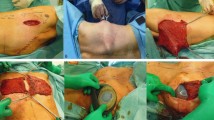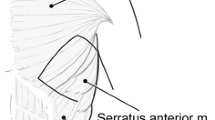Abstract
Introduction
The demand for reconstructive breast surgery after mastectomy is increasing among women and the two-stage option remains the most commonly performed technique. We conducted a self-controlled prospective clinical trial comparing the use of the serratus anterior fascia with the serratus anterior detached fibers to cover the inferolateral aspect of the expander in immediate two-stage breast reconstruction following conservative mastectomies as oncological or risk-reducing procedures.
Patients and Methods
We analyzed the surgical outcome of 29 bilateral mastectomies and immediate reconstruction with the positioning of a tissue expander in a pocket beneath the pectoralis major and serratus anterior muscle on one side and in a pocket beneath the pectoralis major and a serratus anterior fascia flap on the other side. We considered all complications presenting in the first month after surgery and patient-reported early post-operative pain.
Results
Complication rates in the two groups did not significantly differ (p = 0.237). The total amount of drainage and the time of drainage permanence were significantly lower for the subfascial group (p < 0.05). Patient-reported early post-operative pain was significantly different between the two groups both at 24 h (p < 0.05) and at 5 days (p < 0.05) with significantly lower pain scores reported by the patients in the subfascial group.
Discussion
Our self-controlled prospective trial demonstrated an advantage in performing an implant-based two-stage breast reconstruction using a serratus anterior fascia flap when compared with the serratus muscle fibers use for inferolateral implant coverage following mastectomy. The use of the anterior serratus fascia flap for inferolateral implant coverage in two-stage breast reconstructions following mastectomy could be considered as a safe and effective technique, presenting lower morbidity for the patient when compared with the serratus muscle fibers use and lower costs when compared with biological and synthetic meshes use, achieving good outcomes in terms of post-operative complications and women’s quality of life and satisfaction levels.
Level of Evidence III
This journal requires that authors assign a level of evidence to each article. For a full description of these Evidence-Based Medicine ratings, please refer to the Table of Contents or the online Instructions to Authors www.springer.com/00266.

Similar content being viewed by others
References
American Society of Plastic Surgeons 2014 Reconstructive Plastic Surgery Statistics. http://www.plasticsurgery.org/Documents/news-resources/statistics/2014-statistics/reconstructive-procedure-trends-2014.pdf. Accessed 8 May 2016
Djohan R, Gage E, Bernard S (2008) Breast reconstruction options following mastectomy. Cleve Clin J Med 75(Suppl 1):S17–S23
Rocco N, Catanuto G, Nava MB (2015) What is the evidence behind conservative mastectomies? Gland Surg 4(6):506–518
Rocco N, Rispoli C, Moja L, Amato B, Iannone L, Testa S, Spano A, Catanuto G, Accurso A, Nava MB (2016) Different types of implants for reconstructive breast surgery. Cochrane Database Syst Rev 5:CD010895
Radovan C (1982) Breast reconstruction after mastectomy using the temporary expander. Plast Reconstr Surg 69:195–208
Gruber RP, Kahn RA, Lash H, Maser MR, Apfelberg DB, Laub DR (1981) Breast reconstruction following mastectomy: a comparison of submuscular and subcutaneous techniques. Plast Reconstr Surg 67:312–317
Serra-Renom JM, Fontdevila J, Monner J, Benito J (2004) Mammary reconstruction using tissue expander and partial detachment of the pectoralis major muscle to expand the lower breast quadrants. Ann Plast Surg 53:317–321
Apfelberg DB, Laub DR, Maser MR, Lash H (1981) Submuscular breast reconstruction-indications and techniques. Ann Plast Surg 7(3):213–221
Asplund O (1983) Breast reconstruction with submuscular prosthesis after modified radical or simple mastectomy. Surgical technique and early complications. Scand J Plast Reconstr Surg 17(2):141–146
Ward J, Cohen IK, Knaysi GA, Brown PW (1987) Immediate breast reconstruction with tissue expansion. Plast Reconstr Surg 80:559–566
Alani HA, Balalaa N (2013) Complete tissue expander coverage by musculo-fascial flaps in immediate breast mound reconstruction after mastectomy. J Plast Surg Hand Surg 47(5):399–404
Salzberg CA (2012) Focus on technique: one-stage implant-based breast reconstruction. Plast Reconstr Surg 130(5 Suppl 2):95S–103S
Bruant-Rodier C, Chiriac S, Baratte A, Dissaux C, Bodin F (2015) Latissimus dorsi myocutaneous flap combined with implant in breast reconstruction: the technique of the dorsal bra. Ann Chir Plast Esthet. doi:10.1016/j.anplas.2015.05.008
Kim YW, Kim YJ, Kong JS, Cheon YW (2014) Use of the pectoralis major, serratus anterior, and external oblique fascial flap for immediate one-stage breast reconstruction with implant. Aesthetic Plast Surg 38(4):704–710
Salzberg CA (2006) Nonexpansive immediate breast reconstruction using human acellular tissue matrix graft (AlloDerm). Ann Plast Surg 57:1–5
Saint-Cyr M, Dauwe P, Wong C, Thakar H, Nagarkar P, Rohrich RJ (2010) Use of the serratus anterior fascia flap for expander coverage in breast reconstruction. Plast Reconstr Surg 125(4):1057–1064
Lin KY, Blechman AB, Brenin DR (2012) Implant-based, two-stage breast reconstruction in the setting of radiation injury: an outcome study. Plast Reconstr Surg 129:817–823
Nava MB, Cortinovis U, Ottolenghi J, Riggio E, Pennati A, Catanuto G, Greco M, Rovere GQ (2006) Skin-reducing mastectomy. Plast Reconstr Surg 118(3):603–610
Logan Ellis H, Asaolu O, Nebo V, Kasem A (2016) Biological and synthetic mesh use in breast reconstructive surgery: a literature review. World J Surg Oncol 14(1):121
Hartzell TL, Taghinia AH, Chang J et al (2010) The use of human acellular dermal matrix for the correction of secondary deformities after breast augmentation: results and costs. Plast Reconstr Surg 126:1711–1720
Acknowledgement
None of the authors has a financial interest in any of the products, devices, or drugs mentioned in this manuscript.
Author information
Authors and Affiliations
Corresponding author
Rights and permissions
About this article
Cite this article
Bordoni, D., Cadenelli, P., Rocco, N. et al. Serratus Anterior Fascia Flap Versus Muscular Flap for Expander Coverage in Two-stage Breast Reconstruction Following Mastectomy: Early Post-operative Outcomes. Aesth Plast Surg 41, 26–30 (2017). https://doi.org/10.1007/s00266-016-0770-2
Received:
Accepted:
Published:
Issue Date:
DOI: https://doi.org/10.1007/s00266-016-0770-2




